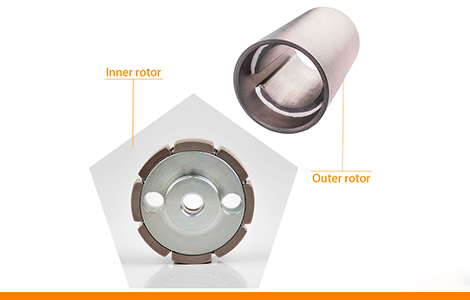
-
Magnet
-
Holding Magnet
-
Separating Magnet
-
Lifting Magnet
-
Machinery Assemblies
-
Industrial Resource
-
About Hiest
Clients always come to me with images of our magnet rotors to request a customized product with certain rated power and RPM. Although the first few cases were difficult with tens rounds of discussion with clients and engineers, after going through some articles and concluding feedbacks from engineers, I’m a customization expert on magnet rotor in the company now. I’m writing down my experiences and tips, hope this article can help those who are encountering same dilemmas.
The magnet rotor is an important component of the motor. It generally consists of an iron sleeve and multiple magnetic tiles, which are assembled together. Magnet rotors are widely used in stepper motors, brushless DC motors, permanent magnet motors and other motors. To design a magnet rotor, the following components need to be considered.
1.Overall Size of the Rotor
The first step to start design a magnet rotor is to determine its overall size. We should confirm the installation space of the rotor to ensure that this space will not be exceeded.
The inner rotor is located between the stator and the shaft, and it’s necessary to confirm the diameter and length of the shaft and the inner diameter and length of the stator. The outer rotor is located between the stator and the casing, and it’s necessary to confirm the outer diameter and extent of the stator and the inner diameter and length of the casing. With above data, the overall size of the rotor is there.
2.Choose the Right Magnets
After electrification, the armature magnetic field generated by the stator winding drives the permanent magnet on the rotor to rotate through the principle of same sex repulsion and irregular phase attraction. This is the working principle of a permanent magnet motor.
During the rotor design, we use advanced software to simulate the magnetic field and calculate. With the data of rated power, RPM, and the working temperature, we are able to get the size and performance level of magnets.
3.Number of Magnetic Tiles
Some rotors are composed of two magnetic tiles, and some are composed of four or six tiles. The number of poles of the motor determines the quantity of magnetic tiles. So with the number of poles of the motor, engineers can calculate the number of magnetic tiles.
4. Whether the Protective Sleeve is Necessary?
According to the previous three points, we have roughly been able to determine the design of the rotor. However, if it is an inner rotor on a high-speed motor, the magnets would be thrown out under the high centrifugal force. We can consider adding a non-magnetic protective sleeve outside the rotor to guarantee the safety.
After comprehensively considering the above design factors, we can customize magnetic rotors that meet the customer's requirements and provide them with the most advantageous products. HIEST has always been focusing on independent designing and developing high-precision production. We have confidence and strength on providing our clients with the best products and services.








